Hepatitis C virus NS4B protein induces epithelial-mesenchymal transition by upregulation of Snail
- PMID: 28431572
- PMCID: PMC5399819
- DOI: 10.1186/s12985-017-0737-1
Hepatitis C virus NS4B protein induces epithelial-mesenchymal transition by upregulation of Snail
Abstract
Background: Chronic hepatitis C virus (HCV) infection is an important cause of hepatocellular carcinoma (HCC). Epithelial to mesenchymal transition (EMT) is a key process associated with tumor metastasis and poor prognosis. HCV infection, HCV core and NS5A protein could induce EMT process, but the role of NS4B on EMT remains poorly understood.
Methods: We overexpressed HCV NS4B protein in HepG2 cells or Huh7.5.1 cells infected by HCVcc, the E-cadherin expression, N-cadherin expression and the EMT-associated transcriptional factor Snail were determined. The migration and invasion capabilities of the transfected cells were evaluated using wound-healing assay. Additionally, we used Snail siRNA interference to confirm the relation of HCV NS4B and Snail on EMT promotion.
Results: HCV NS4B increased the expression of EMT related markers and promoted cell migration and invasion. Snail knock-down almost completely eliminated the function of NS4B protein in EMT changes and reversed cell migration capacity to lower level. HCV NS4B protein could reduce the expression of Scribble and Hippo signal pathway were subsequently inactivated, resulting in the activation of PI3K/AKT pathway, which may be the reason for the up-regulation of Snail.
Conclusions: This study demonstrates that HCV NS4B protein induces EMT progression via the upregulation of Snail in HCC, which may be a novel underlying mechanism for HCV-associated HCC development, invasion and metastasis.
Keywords: Cadherin; Epithelial to mesenchymal (EMT); HCV; Hippo pathway; Snail.
Figures
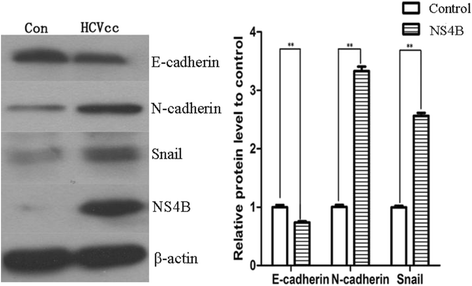
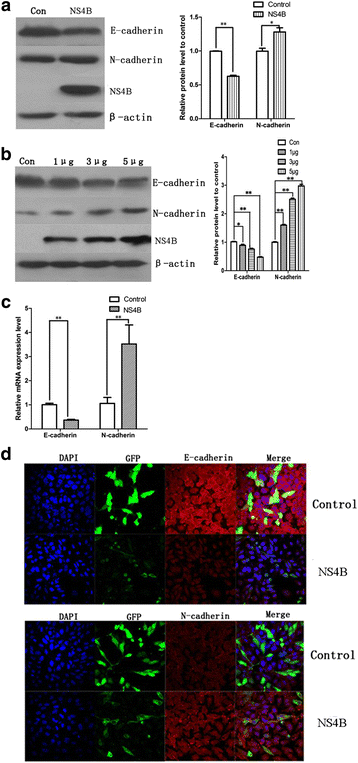
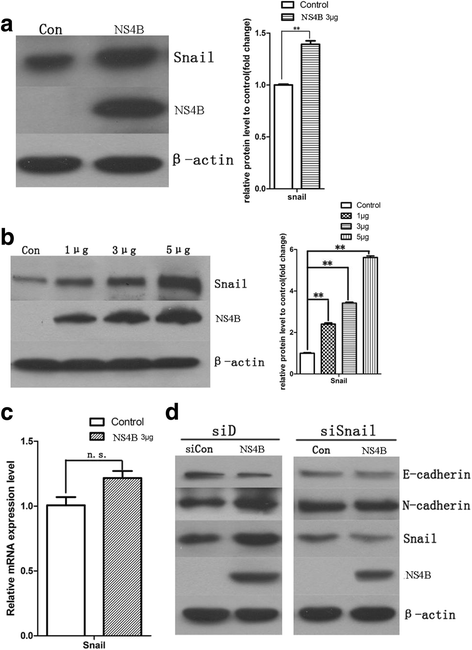
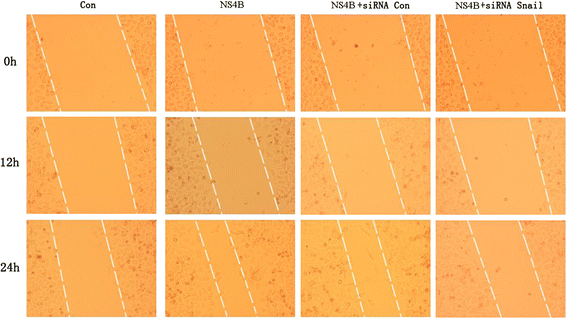
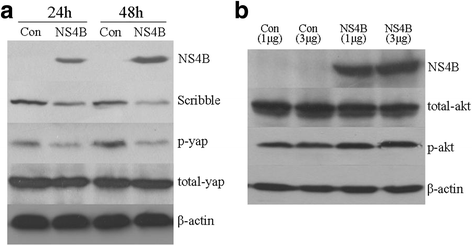
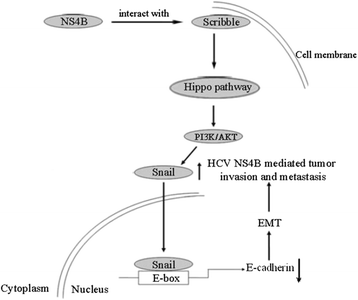
Similar articles
-
Hepatitis C virus core protein induces epithelial-mesenchymal transition in human hepatocytes by upregulating E12/E47 levels.Cancer Lett. 2015 Jun 28;362(1):131-8. doi: 10.1016/j.canlet.2015.03.032. Epub 2015 Mar 27. Cancer Lett. 2015. PMID: 25817725
-
Hepatitis C virus core protein interacts with Snail and histone deacetylases to promote the metastasis of hepatocellular carcinoma.Oncogene. 2016 Jul 14;35(28):3626-35. doi: 10.1038/onc.2015.428. Epub 2015 Nov 9. Oncogene. 2016. PMID: 26549030
-
FoxM1 overexpression promotes epithelial-mesenchymal transition and metastasis of hepatocellular carcinoma.World J Gastroenterol. 2015 Jan 7;21(1):196-213. doi: 10.3748/wjg.v21.i1.196. World J Gastroenterol. 2015. PMID: 25574092 Free PMC article.
-
Impact of HCV Infection on Hepatocyte Polarity and Plasticity.Pathogens. 2022 Mar 10;11(3):337. doi: 10.3390/pathogens11030337. Pathogens. 2022. PMID: 35335661 Free PMC article. Review.
-
Hepatitis C virus infection: establishment of chronicity and liver disease progression.EXCLI J. 2014 Aug 27;13:977-96. eCollection 2014. EXCLI J. 2014. PMID: 26417315 Free PMC article. Review.
Cited by
-
Epithelial mesenchymal transition (EMT): a universal process in lung diseases with implications for cystic fibrosis pathophysiology.Respir Res. 2018 Jul 18;19(1):136. doi: 10.1186/s12931-018-0834-8. Respir Res. 2018. PMID: 30021582 Free PMC article. Review.
-
The Epithelial-to-Mesenchymal Transition-Like Process Induced by TGF-β1 Enhances Rubella Virus Binding and Infection in A549 Cells via the Smad Pathway.Microorganisms. 2021 Mar 23;9(3):662. doi: 10.3390/microorganisms9030662. Microorganisms. 2021. PMID: 33806778 Free PMC article.
-
Hepatitis C virus nonstructural protein 4B induces lipogenesis via the Hippo pathway.Arch Virol. 2023 Mar 15;168(4):113. doi: 10.1007/s00705-023-05743-4. Arch Virol. 2023. PMID: 36920600 Free PMC article.
-
Relationship between epithelial-to-mesenchymal transition and the inflammatory microenvironment of hepatocellular carcinoma.J Exp Clin Cancer Res. 2018 Aug 29;37(1):203. doi: 10.1186/s13046-018-0887-z. J Exp Clin Cancer Res. 2018. PMID: 30157906 Free PMC article. Review.
-
PI3K/Akt/HIF-1α signaling pathway mediates HPV-16 oncoprotein-induced expression of EMT-related transcription factors in non-small cell lung cancer cells.J Cancer. 2018 Sep 8;9(19):3456-3466. doi: 10.7150/jca.26112. eCollection 2018. J Cancer. 2018. PMID: 30310502 Free PMC article.
References
Publication types
MeSH terms
Substances
LinkOut - more resources
Full Text Sources
Other Literature Sources
Research Materials

